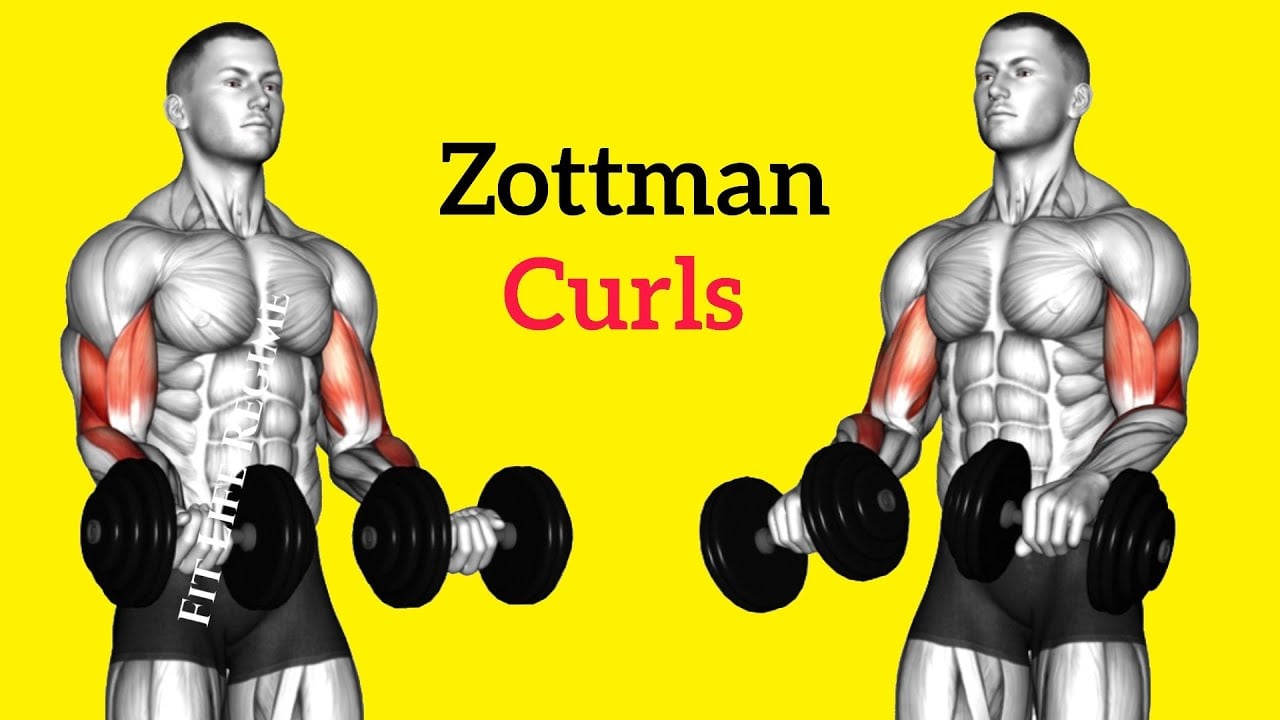Many people focus on traditional bicep exercises, such as the barbell curl (for a good reason), but the zottman curl offers a unique and highly effective way to target your biceps and forearm.
But what sets Zottman curls apart from other bicep curl variations? Zottman curls work not only the bicep muscles but also the forearm muscles, which are often overlooked when doing regular bicep curls.
This unique movement is named after George Zottman, a professional strongman from the early 1900s.
It is a combination of bicep curls and reverse curls. Instead of curling both (concentric and eccentric) with your palms facing up, you curl up with your palms facing up (supinated) and curl down with your palms facing down (pronated).
- The first upward portion, the regular curl, focuses on bicep strength.
- The second lowering portion, the dumbbell reverse curl, allows you to overload the forearms.
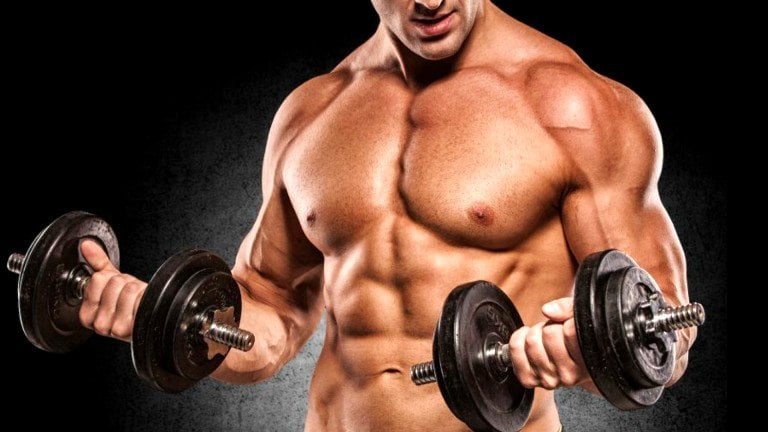
- Zottman Curl Muscles Worked
- How To Do Zottman Curl
- Proper Form and Technique
- Zottman Dumbbell Curl Variations
- 1. Incline Zottman Curl
- 2. Spider Zottman Curl
- 3. Preacher Zottman Curl
- 4. Seated Zottman Curl
- 5. Alternating Zottman Curl
- Zottman Curl Benefits
- FAQs
- Is the Zottman curl suitable for beginners?
- What does the Zottman Curl work?
Zottman Curl Muscles Worked
- The Zottman curl, primarily works the biceps brachii, and forearm flexors muscles.
- A handful of other muscles work or play the role of stabilizer muscles, including your Brachialis, Brachioradialis, and forearm extensor muscles.
- The Zottman curl involves several synergist muscles, including oblique and core muscles.
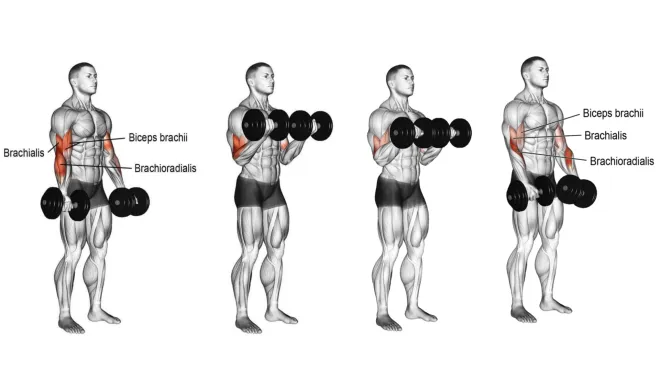
How To Do Zottman Curl
- Stand with your feet shoulder-width apart and your knees slightly bent.
- Hold a dumbbell in each hand with a supinated grip (palms facing up).
- Extend your right arm down to the side of the body.
- Keep your elbows close to your sides as you curl the dumbbells up towards your shoulders.
- Pause at the top of the movement.
- Then, slowly rotate your grip (forearm 180 degrees) so your palms face downwards.
- Now, slowly lower the dumbbells back to the starting position.
- Rotate the forearm 180 degrees again and then repeat with the same arm for the desired number of repetitions.
Proper Form and Technique
- Your body should remain fixed. Only your biceps should be used to move the weight.
- Don’t underestimate the pause at the top of your curl, and take a moment to squeeze your bicep when you get there.
- A slow controlled descent will increase time under tension, leading to more effective sets, and less risk of injury.
- Ensure that your elbows are kept close to your sides with your knees slightly bent, and your hands gripped tightly to the bar.
- Always select a weight that allows you to have full control of your body throughout the movement.
- Incorporate proper warm-ups, rest, and nutrition into your exercise program.
- Make sure to rotate your forearms fully from supinated to pronated at the top of the movement.
- Rest for 24 to 48 hours before training the same muscle groups to allow sufficient recovery.
- Perform this exercise in a slow, controlled manner for best results.
- Don’t go heavy. Choose a lighter weight and focus on perfecting your form.
- It is recommended to do 3–4 sets of 8–12 reps of the Zottman curl as a bicep workout routine or with other compound exercises such as lat pulldown, Barbell row, and deadlift.
- Select the set, reps, and frequency for the Zottman dumbbell curl per your fitness level.
| Level | Sets | Reps | Frequency (per week) |
|---|---|---|---|
| Beginner | 2-3 | 8-10 | 1 |
| Intermediate | 3-4 | 8-12 | 1-2 |
| Advanced | 4-5 | 8-15 | 2-3 |
Zottman Dumbbell Curl Variations
There are different ways to do a Zottman Curl to build a bigger and stronger bicep and to keep your workout routine fresh and challenging. Here are a few popular variations you can try:
- Alternating Zottman Curl
- Incline Zottman Curl
- Preacher Zottman Curl
- Spider Zottman Curl
1. Incline Zottman Curl
The incline Zottman curl engages multiple muscles in the upper arm, including the biceps brachii, brachialis, and brachioradialis. This leads to a more comprehensive and balanced development of the entire arm.
It targets different regions of the arm by using both supinated and pronated grips.
- A supinated grip works the bicep and brachialis muscles during the concentric phase.
- During the eccentric phase, the pronated grip emphasizes the brachioradialis and forearm muscles, improving forearm size and grip strength.

How To Do
- Set an incline bench to a comfortable angle, typically around 45 degrees.
- Sit on the bench with your back against it and feet flat on the ground.
- Hold a dumbbell in each hand with a supinated grip (palms facing up) and dumbbells hanging by your sides.
- Inhale and move the dumbbells towards your shoulder.
- Keep curling until the dumbbells are close to your shoulders.
- Pause briefly at the top of the movement, then rotate your forearm 180 degrees (palms facing down).
- Slowly return the dumbbells to their starting position..
Know More: Incline Dumbbell Curl: Muscle Worked, How To Do & Form
2. Spider Zottman Curl
The dumbbell spider zottman curls are a remarkable exercise for building the biceps and forearms because they produce an intense muscle contraction on every single rep.
This is a good way to try something new and make your arms work hard. It’s especially good for your short head of bicep and forearm muscles, which will do most of the work.
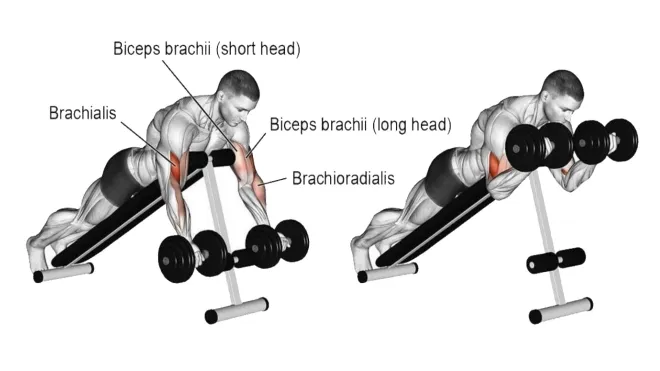
How To Do
- Adjust the bench to an incline and level to a 45-degree angle.
- Grab two moderately light dumbbells with an underhand grip.
- Lie on the bench in a reverse position with your chest pressed onto the backrest.
- Your legs should be long with a slight bend in your knees.
- Curl the dumbbells toward your shoulders and squeeze your biceps forcefully.
- Once the dumbbells are at shoulder height, rotate your forearms so your palms face down.
- Slowly lower the dumbbells back to the starting position.
- That’s one repetition.
Know More: Spider Curls: Muscle Worked, Benefits, Alternate & Tip
3. Preacher Zottman Curl
The Preacher Zottman curl works the biceps brachii muscles better than standing variations.
If you rest your arms on the preacher curl bench, you minimize the involvement of other muscle groups, such as the deltoids or upper back. This allows for a more focused and intense contraction of the biceps.
This can enhance the strength, stability, and size of your forearm, including the brachioradialis and wrist flexors.
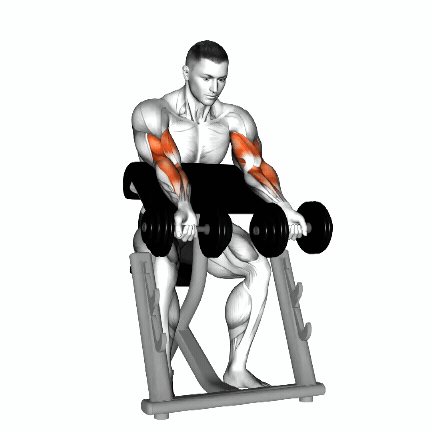
How To Do
- Adjust the preacher bench so that your elbows are slightly above the level of your shoulders.
- Grasp a dumbbell in each hand with a supine grip (palms facing upward) and sit on the preacher curl bench.
- Keep your upper arms against the pad and slightly bend your elbows.
- Curl the dumbbells up towards your shoulders.
- Once you reach the top of the curl, rotate your forearms so your palms face away from your body (pronated grip).
- Slowly lower the dumbbells back to the starting position.
- That’s one repetition.
Related Post: Preacher Curl: How To Do It Correctly And Best Variation
4. Seated Zottman Curl
The seated position provides stability and support and allows for better isolation of the biceps and forearms muscles.
A seated position reduces the reliance on momentum or swinging and ensures proper form and controlled movement.
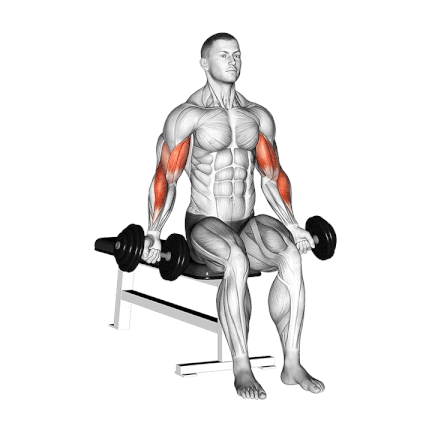
5. Alternating Zottman Curl
The alternating Zottman curl involves curling one arm while the other arm is in the extended position. As you lower the weight with one arm, you simultaneously curl the weight with the other arm, alternating the movement between each arm.
It creates a good mind-muscle connection and also helps you fix any imbalances in strength or size between your left and right arms, encouraging arm growth.
Want to take your gains to the next level? Discover your daily calorie needs with our free TDEE calculator
Zottman Curl Benefits
The benefits of Zottman curls include:
- Targeted bicep strength and size.
- Enhanced development of forearm muscles.
- Improved grip strength and wrist mobility.
- Increased brachialis muscle activation.
- Improved appearance and symmetry of the arms.
- Enhanced functional strength for daily activities and sports.
- Reduced risk of arm injuries through improved joint stability.
- Versatility and easy integration into workout routines.
FAQs
Is the Zottman curl suitable for beginners?
Yes, the Zottman curl can be performed by beginners, provided they start with a light weight and focus on proper form and technique.
What does the Zottman Curl work?
The Zottman curl primarily works the biceps brachii (both long and short heads), brachialis, and brachioradialis muscles. Additionally, it engages the forearm muscles, including the wrist extensors, during the movement’s eccentric (lowering) phase.

Manish is a NASM-certified fitness and nutrition coach with over 10 years of experience in weight lifting and fat loss fitness coaching. He specializes in gym-based training and has a lot of knowledge about exercise, lifting technique, biomechanics, and more.
Through “Fit Life Regime,” he generously shares the insights he’s gained over a decade in the field. His goal is to equip others with the knowledge to start their own fitness journey.

